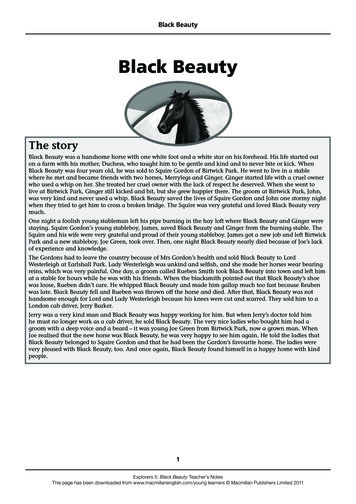
Transcription
Never Be Lied to Again:How to Get the Truth Out of Anyone!Part 1: How to Tell If You Are Being Lied toBy David J. Lieberman, Ph.D.Excerpts from "Never Be Lied to Again"expression comes after the verbal statement (“I am so angrywith you right now” pause and then the angry expression), it looks false. The head moves in a mechanical fashion without regard toemphasis, indicating a conscious movement.In an ideal society there would be no need for lies. But welive in a world of deception. And whether you want to play ornot, you’re in the game. The question is, do you want to win?Once you realize that you’re being lied to, should you confront the liar immediately? Usually not. The best approach isto note the fact in your mind and continue with the conversation, trying to extract more information.Once you confront someone who has lied to you, the tone ofthe conversation changes and gathering additional facts becomes difficult. Therefore, wait until you have all the evidenceyou want and then decide whether to confront the person atthat time or hold off to figure how you can best use this insightto your advantage.How to Tell If You Are Being Lied ToBody Language The person will make little or no eye contact. A person whois lying to you will do everything to avoid making eye contact. Physical expression will be limited, with few arm and handmovements. What arm and hand movements are present willseem stiff, and mechanical. Hands, arm and legs pull in toward the body; the individual takes up less space. His hand(s) may go up to his face or throat, especially tothe mouth. But contact with his body is limited to these areas.He is also unlikely to touch his chest with an open hand gesture. He may also touch the nose or scratch behind the ear. If he is trying to appear casual and relaxed about his answer, he may shrug a little.Emotional States: Consistency and Contradiction The timing is off between gestures and words. If the facial Gestures don’t match the verbal message, such as frowningwhen saying “I love you.” Hands tightly clenched and a statement of pleasure are not in sync with each other. The timing and duration of emotional gestures will seem off.The emotion is delayed coming on, stays longer than itshould, and fades out abruptly. Expression will be limited to the mouth area when the person is feigning certain emotions – happiness, surprise, awe,and so on – rather than the whole face.Interpersonal InteractionsWhen we are wrongfully accused, only a guilty person getsdefensive. Someone who is innocent will usually go on theoffensive. He is reluctant to face his accuser and may turn his heador shift his body away. The person who is lying will probably slouch; he is unlikelyto stand tall with his arms out or outstretched. There’s movement away from his accuser, possibly in thedirection of the exit.
There will be little or no physical contact during his attempt to convince you. He will not point his finger at the person he is trying to convince. He may place physical objects (pillow,drinking glass, et cetera) between himself and his accuser to form a barrier,with a verbal equivalent of “I don’t wantto talk about it,” indicating deception orcovert intention.What Is Said: Actual Verbal Content He will use your words to make hispoint. When asked, “Did you cheat onme?” The liar answers, “No, I didn’tcheat on you.” In addition, when a suspect uses a contraction – “It wasn’t me”instead of “It was not me” – statistically,there is a 60% chance he is truthful. He may stonewall, giving an impression that his mind is made up. This isoften an attempt to limit your challengesto his position. If someone says right upfront that he positively won’t budge, itmeans one thing: He knows he can beswayed. He needs to tell you this so youwon’t ask, because he knows he’ll cavein. The confident person will usephrases like “I’m sorry, this is prettymuch the best we can do.” Watch out for the good old Freudianslip. He depersonalizes his answer by offering his belief on the subject insteadof answering directly. A liar offers abstract assurances as evidence of his innocence in a specific instance.Example: “Did you ever cheat on me?”and you hear, “You know I’m againstthat sort of thing. I think it morally reprehensible.” He will keep adding more informationuntil he’s sure that he has sold you onhis story. The guilty are uncomfortablewith silence. He speaks to fill the gapleft by the silence. He may imply an answer but neverstate it directly.How Something Is Said Deceitful response to questions regarding beliefs and attitudes take longerto think up. However, how fast does therest of the sentence follow the initialone-word response? In truthful statements a fast no or yes is followedquickly by an explanation. If the personis being deceitful the rest of the sentence may come more slowly becausehe needs time to think up an explanation. Watch out for reactions that are all outof proportion to the question. May repeat points that he has already made.May also be reluctant to use words thatconvey attachment and ownership orpossessiveness (“that car” as opposedto “my car”). The person who is lying may leave outpronouns and speak in a monotonousand inexpressive voice. When a personis making a truthful statement, he emphasizes the pronoun as much as ormore than the rest of the sentence. Words may be garbled and spokensoftly, and syntax and grammar may beoff. In other words, his sentences willlikely be muddled rather than empha-sized. Statements sound an awful lot likequestions, indicating that he’s seekingreassurance. Voice, head and eyes liftat the end of their statement.Psychological Profile We often see the world as a reflectionof ourselves. If you’re being accused ofsomething, check your accuser’s veracity. Watch out for those people who arealways telling you just how corrupt therest of the world is. Beware of thoseasking you if you believe him. They mayrespond with, “you don’t believe me, doyou?” Most people who tell the truth expect to be believed. Look at whether his focus is internal orexternal. When a person is confidentabout what he’s saying, he’s more interested in your understanding him andless interested in how he appears toyou. In a liar’s story, he will usually not givethe point of view of a third party. To illustrate giving a point of view of someone else, “My roommate was soshocked that I would ”
In relating a story, a liar often leavesout the negative aspects (unless thestory is used to explain way he was delayed or had to cancel plans). The storyof a vacation, for example, should haveboth positive and negative aspects ofwhat happened. A liar willingly answers your questionsbut asks none of his own. For example,during their first intimate encounter,Randy asks his new girlfriend if she’sever been tested for AIDS. She responds with “Oh, yes, certainly,” andcontinues on a bit about annual checkups, giving blood, etc. And then nothing!If she was concerned about her health,as her answer implied, then she wouldhave asked him the same question. Theliar is often unaware that coming acrossas truthful means both answering andasking questions.General Indications of Deceit Whenthe subjectischanged,he’s in abetter,more rel a x e dmood.The guiltywants thesubjectchanged;the innocent always wants a further exchange of information. He does not become indignant whenfalsely accused. While he is being accused the liar will remain fairly expressionless. The liar is more concernedwith how he is going to respond than heis with the accusation itself. He uses such phrases as “To tell youthe truth,” “To be perfectly honest,” and“Why would I lie to you?” He has an answer to your questiondown pat, such as giving precise detailto an event occurring two months ago. He stalls by asking you to repeat thequestion or by answering your questionwith a question. “Where did you hearthat?” “Could you be more specific?” oreven repeating your question back toyou, at an attempt at sounding incredulous. For example, “Did I sell you apuppy with a heart condition? Is thatwhat you’re asking me?” What he’s saying sounds implausible,such as “During the past ten years, Ihave never used a specific racial epithet.” He offers a preamble to his statementstarting with “I don’t want you to thinkthat ” Often that’s exactly what hewants you to think. Whenever someonemakes a point of telling you what they’renot doing, you can be sure it’s exactlywhat they are doing. Such as, “Not tohurt your feelings, but ” He implies through a form of denial.You hear, “He’s having marital problems, but it has nothing to do with hiswife’s new job.” What’s the first thingyou ask? “What does his wife do?” Suddenly you’re in the exact conversationthat is “supposed” to have no bearingon the facts. He uses humor or sarcasm to defuseyour concerns, rather than respondingseriously. He offers you a “better” alternative toyour request when he is unable to giveyou what you originally asked for. Before you accept someone at his wordthat he has something better to offer,first see whether he has what you originally asked for. If he doesn’t, then youshouldn’t believe him. All of his facts relating to numbers arethe same or multiples of one another.Watch out when facts, figures, and information have unusual similarities. There is evidence of involuntary responses that are anxiety based. Anxietycauses many things. His breather mayappear as a deep, audible inhaling in anattempt to control his breathing to calmhimself. Swallowing becomes difficult;he may clear his throat. His ability tofocus on something is often diminished,unable to pay attention to what’s goingon. He uses an obvious fact to support adubious action. For example, let’s saythat a guard is standing watch over a restricted area. It’s his job to check ID’s ofthose who enter. “I’m not sure you haveauthorization,” he says to a man attempting access. “I’m not surprised,”answered the man, “only a few peopleare aware of my clearance level. Mywork here is not supposed to be knownby everyone.” He casually tells you something thatdeserves more attention.
He exclaims his displeasure at the ac-tions of another who has done something similar so that you will not suspecthim. For instance, if he is trying to throwyou off track of his embezzlementscheme, he may openly chastise another employee for “borrowing” someoffice supplies for personal use athome. Your impression is that he ismoral person who objects to somethingas minor as stealing office supplies.Certainly he cannot be responsible fora large-scale embezzlement scheme. He may casually tell you somethingthat should deserve more attention. “Ohby the way, I’ve got to go out of townnext weekend on business.” If he doesn’t usually travel for work on the weekends, then you would expect her tomake a point of how unusual the trip is.Her downplaying the trip makes it suspicious. When something out of the ordinary happens and the person doesn’tdraw attention to it, it means that he istrying to draw attention away from it.Another tactic is running off a long listof items in the hope that one will remainunnoticed. If he lies about one thing, everythinghe says is questionable. His story is so wild that you almostdon’t believe it. But you do, because ifhe wanted to lie, you think that he wouldhave come up with something moreplausible.This article is an excerpt from "NeverBe Lied to Again," available in the Underground Hypnosis package availableat here: "Learn the Underground Hypnosis Secrets of the World's Most Dangerous Hypnosists"School security guardinspires students withcoloring bookBRIDGEPORT -- Positive thoughts popinto Harry A. Bell's head all the time.Sayings like: "A fresh start will helpbegin a great day;" or "Do not let a let-down keep you down" just seem to popinto his brain.Bell, 29, used to jot down these motivational ditties and dream about puttingthem on coffee mugs.Then his son, Sa-Nahj Bell, gave him abetter idea.Bell, who works as a security guard 32hours a week at the University ofBridgeport and 40 hours at James J.Curiale School, created a coloring book.The book, "Color a Positive Thought,"has now become a big hit at the Curialeschool. Principal Brett Gustafson usedabout 1,000 in discretionary funds thisfall to buy 250 copies, enough for all thechildren in grades two through four atthe school."I looked at it and said Whoa, this issome good stuff," Gustafson said. "Thisfit in perfectly."The Curiale school is in its third year inthe state Commissioner's Network,which focuses extra funds and oversight on the most troubled schools. Aspart of the network, one of Curiale'sgoals has been to change student behaviors. Gustafson said he is always onthe hunt for incentives that carry positive messages and remind students "It'snot where you start but where you finish."WAVE Safety & Security NewsProduced by theSecurity DepartmentLong Branch Public Schools540 BroadwayLong Branch, NJ 07740732-571-2868Walter J. O’Neill, JrDistrict Public Safety Liaisonwoneill@longbranch.k12.nj.us
Bell's book is full of such messages. Hecreated scenes with big-eyed schoolchildren doing things like reading in onepanel and then showing off an A gradein the next."I just wanted kids to see positives inlife," Bell said.He loved the reaction in teacher AmyGress's second grade class when theyreceived the books days beforeThanksgiving."You did this?" Tatiana Garner, 7,asked, before giving Bell a hug.Bell said students at the school keephim on his feet but, he said, the perception the outside world has of Curialestudents is totally wrong."I'd love to start an empowerment program to help them," he said.Born and raised in Bridgeport, Bell'sown start was pretty difficult. His mom,addicted to drugs, left him at the hospital a birth. An aunt, Marvetta Bell, cameto collect him and raised him until hewas 18. In the third grade, thingsstarted to look up. He got a mentor -Howard Owen Jr. -- who treated him likefamily. He remains close to this day.He also had a cousin, Tonahja Cohen,who had a barber shop and gave him ajob sweeping up hair from the age ofeight.his barbering skills."When you shape up, you got to havehair lines and angle on points," he said."With sketching you are just sketchingout points and circles."Still, the sketching and sayings didn'tcome together until Sa-Nahj was born."My son was the inspiration," Bell said."I went to the store looking for coloringbooks that would empower him. I evenlooked it up on Google and couldn't findnothing."He went back to his sketches and decided to put them together. Friends EdHernandez and Solomon Stanley,helped him translate his sketches ontothe computer. He self-published thebook.An early draft of the book, completedthis summer, had his son's face on thecover. The finished product features astring of children holding hands, and 12pages to color.In three months, he has sold about 400copies and held a book signing at theSono Library in Norwalk. Bell has nowebsite, but can be reached throughemail at H.KSmarts@yahoo.com.Bell now has a second coloring book inthe works.School terrorismpreparedness: After the ISIAattach in Paris, is the U.S.the next target?"He said if I graduated from high schoolhe would give me a chair," Bell said."He taught me how to cut." After hegraduated from Central High School,Bell got that chair.If terrorists want to strike at the heart ofAmerica, they will strike at its children.His sketching skills, he said, grew out ofI made that comment before and afterthe 9/11 attacks on United States. Thispast weekend’s ISIS attacks in Paris,France, are a tragic reminder that thiscomment still applies now, if not morethan ever, here in America today.A historical glance back at discussionson schools and terrorismDomestic terrorism was touched upfrom my perspective when I mentionedit in a discussion of bombs and bombthreats in my first book in 1998. I revisited it again in a subchapter in my 2000book with reflections on internationaland domestic terrorism attacks. In mylatest book on Proactive School Security and Emergency PreparednessPlanning, I dedicated a chapter toschool terrorism preparedness.Following9/11, a coupleof my colleagues and Itooksomehitsfromnaysayersand fence riderswhodared not tobroach the issue of U.S. schools beingterror targets. But after the 2004 terrorist attack on a school in Beslan, Russia,the U.S. Department of Education sentout a letter to educators addressingschool preparedness in light of theBeslan attack, and a few presenters onschool safety stepped up to moreopenly acknowledge this threat. In2003, my colleague Chuck Hibbert andI participated in a National StrategyForum (NSF) two-day workshop of experts that culminated in recommendations published on Schools: PrudentPreparation for a Catastrophic Terrorism Incident.
Sadly, our federal officials and othersfailed to meaningfully build upon the2004 Department of Education letterand the NSF forum recommendationsand other measures, and the conversation and action on schools as terroristtargets largely ceased at that point. Totheir credit, Congress and the ClintonAdministration created and funded whateventually became known as theReadiness and Emergency Management for Schools (REMS) school emergency planning grant program, whichbrought about many successful projectsand lessons learned that were sharedwith schools and their first respondersnationwide. Unfortunately, this programwas destroyed when the Obama Administration and Congress eliminated itfrom the federal budget shortly afterPresident Obama took office, and todate it has not been restored in its original form where grant resources for thisspecific purpose are directly madeavailable to schools.In 2007, I was invited to testify beforeCongress when the House HomelandSecurity Committee when they held afull committee hearing on school readiness and emergency preparednessplanning. A major thrust of my recommendations focused upon the need forour public officials to acknowledge thethreat of terrorism to our nation’sschools and school buses. I submittedsix key recommendations to restoreand strengthen cut school emergencypreparednessfunding,andtostrengthen interagency coordination onschool readiness and emergency preparedness planning.Now eight years later since that 2007Congressional hearing, myself and others are still waiting for the REMS program to be restored following itselimination, and for meaningful discussions to be held on schools as targetsfor terrorists.Revisiting U.S. schools as potential terrorist targetsThe ISIS attacks in Paris this pastweekend are a chilling reminder of ourvulnerability here in the United States.Undoubtedly, we are better preparedwith improved homeland security measures in our airports and other facilitiesthan we were pre-9/11. But to a largeextent, American schools remain softtargets and vulnerable to a terrorist attack due to the decline in momentumand resources that were generatedafter the 1999 Columbine attack andthe 9/11 attack on our nation.It is time for Congress and the ObamaAdministration, and the next incomingpresidential administration as well, tofocus discussions, planning, programsand funding on school emergency preparedness. Hold some hearings in Congress to get expert input on schools andschool buses as potential terrorist targets. Get the Education, Homeland Security and Justice departments to focuspolicy specifically on schools andschool buses as potential targets of terrorism.Then act: Do something beyond talkingabout it. Restore the REMS grant program and funding to get resources backin the hands of local schools. Keep theconversation moving down to the locallevel to get our new generation ofschool administrators and crisis teamsthinking and better prepared on schoolemergency readiness.Strengthening school security andemergency preparedness during timesof heightened terrorism threatsSuperintendents, principals, schoolboards and their first responders cantake a lead in strengthening their schoolsecurity and emergency preparednessduring times of heightened terroristthreats. Many practical steps for heightened school security and emergencypreparedness have long been outlinedon our dedicated web site page onSchool Terrorism Preparedness. I encourage you to spend some time visiting that site.Then encourage your education associations and legislators to restoreschool emergency preparedness planning programs and funding to helpschools better prepare for a terrorist attack. Let’s not wait for six suicidebombers to walk into random schoolsacross the United States. The threat toour nation and to our schools is real.And right now, we could and should bedoing more in a balanced, rational andcomprehensive way.Ken Trump
The Medical Examiner’s Office inLouisville will perform an autopsy to determine the exact manner and cause ofdeath.The investigation is being conducted bydetectives of KSP Post 3 and is beinghandled as a homicide. KSP was assisted on the scene by Scottsville PoliceDepartment, Allen County Sheriff’s Department and the Allen County Coroner’s Office.SATURDAY: The body of a juvenile wasfound Saturday in a creek in Scottsville,according to Kentucky State Police Post3 spokesman Trooper B.J. Eaton.KSP treating death of Allengirl, 7, as homicideThe Daily News11-15-205Kentucky State Police are treating thedeath of an Allen County girl Saturdayas a homicide.At 7:40 pm Saturday, the mother of 7year-old Gabriella Doolin of AllenCounty reported to the Scottsville PoliceDepartment that her child was missingfrom a football game they were attending on the Allen County-Scottsville HighSchool campus property, according to aKSP news release.A search began immediately and it wasreported to the KSP Post 3 in BowlingGreen at 8:05 p.m. that her body hadbeen located in a creek in a woodedarea behind the high school, accordingto the release.The creek where the child's body wasfound is in an area near Allen CountyScottsville High School. Eaton was notimmediately able to provide further details.Police: 2 Football PlayersHazed, Assaulted inLocker Room4 NBC Washington11-15-2015A Virginia teen has been arrested oncharges including attempted sodomy inconnection with the alleged hazing andassault of two Spotsylvania CountyHigh School football players.Detectives said the sheriff's office wasmade aware of the alleged assault thatoccurred in the boys' locker room at theschool. They said their investigationshowed that two juvenile boys, ages 14and 15, had been hazed and assaultedby older student-athletes prior to anaway game on Oct. 23.The victims were reluctant to admit tobeing assaulted but eventually confirmed the attacks.Detectives were able to identify one ofthe juvenile suspects, a 15-year-old. Hewas taken into custody and chargingwith attempted sodomy with an inanimate object, a felony, and assault bymob, a misdemeanor. The juvenile suspect was transported to the Rappahannock Juvenile Detention Facility."This incident, causing the victimizationof our young people, is a very seriousmatter," said Sheriff Roger L. Harris."Schools should be a safe haven for ourkids, and we will continue to thoroughlyinvestigate this matter."Detectives and school resource officersare continuing the investigation of thismatter, and several additional juvenilesare being sought for interviews.
West Covina student arrestedafter threateningto kill teacherMynewsLA.com11-13-15A 15-year-old West Covina High Schoolstudent with a history of making threatswas arrested after he told a teacher hewas going to shoot and kill her and thentold a school resource officer he wouldshoot and kill as many officers as hecould, police said Friday.The student was arrested about 9:30a.m. Tuesday, West Covina police Officer Eddie Flores said.The boy “was mumbling in class andshouting profanities out loud,” Floressaid.“The teacher asked him several timesto stop cursing in class with no success.At one point, another student asked thesuspect to stop. The suspect replied bysayinghe wasgoing tokill theteacher.”Girl Missing After BeingDropped off at School6 South Florida NBC11-15-2015The Miami-Dade School Police Department is searching for a 14-year-old girlwho was last seen being dropped of atMiami Carol City Senior High on Thursday.Enieya Carter was wearing khaki capripants, a red hoodie, and white high-topNike sneakers.Anyone with information about EnieyaCarter should contact the police.T h eteacherasked the boy to leave the room andfollowed him out, at which point he toldher he was “going to shoot her in theface and watch her die,” Flores said.When the school’s resource officer responded, the suspect attempted to assault him but was instead brought undercontrol without the use of force and arrested.
Waterville police looking intoaccusations about principalby former N.H. studentsPortland Press Herald11-15-2015They have received 'more than one'communication alleging the 'same typeof behavior' occurred at Don Reiter'sformer workplace.Gregg Frame, left, attorney for Waterville Senior High School principal Don Reiter, right, responds Tuesday to allegations that his clientengaged in inappropriate conduct with a student in August. The exchange occurred duringa public hearing at the George J. MitchellSchool in Waterville.WATERVILLE — Police in Watervilleare investigating reports from formerstudents of Don Reiter in New Hampshire that the principal exhibited behavior there that is similar to what is beingalleged by a student at Waterville Senior High School.Reiter is accused of asking a femalestudent for sex Aug. 27 in his office,and has been on administrative leavesince Sept. 1.Superintendent Eric Haley has recommended that Reiter be dismissed fromhis job. The Waterville Board of Education is expected to vote Monday – thethird day of his dismissal hearing – onwhether to fire him or return him to hisjob.On Sunday,WatervillePolice ChiefJ o s e p hMasseysaid someformer studentsofReiteratMascenicRegionalH i g hSchool in New Ipswich, New Hampshire, have been calling his departmentsince Thursday, saying he exhibitedsimilar behavior when he was there.Massey did not say specifically whatthe former students are alleging. Meanwhile, the Morning Sentinel has received tips about allegations.“We have been contacted by some former students who attended a highschool where Mr. Reiter was employed,and they are alleging the same type ofbehavior as alleged in the Watervillecase,” Massey said. “We are currentlylooking into this.”Asked how many former New Hampshire students have contacted Waterville police, Massey said more thanone.Before coming to Waterville, Reiter,now 44, of Mount Vernon, was principalfor three years at Buckfield Junior-Senior High School in Buckfield. Beforethat, he taught social studies for sixyears in New Ipswich, and after twoyears became chairman of the socialstudies-foreign language departmentthere. Two years later, he became assistant principal.Reiter’s attorney, Gregg Frame, saidvia email that he had just heard aboutthe New Hampshire allegations overthe weekend.“I certainly find it curious that thiscomes up the weekend before theboard is to continue deliberations onDon’s dismissal Monday, and that thereis nothing similar from Waterville orBuckfield (a decade plus) after 2½months of investigating Don,” Framesaid in the email. “Don’s leave was in(news)papers in New Hampshire inearly September. The superintendenthad 2.5 months to prepare his casewith the police cooperating fully. Theywere able to produce NOTHING otherthan a single uncorroborated allegation. This is just further evidence in mymind of the superintendent and policetrying to find what they can to supporttheir theory of the case, as opposed todealing in facts. We’ll obviously need toknow more about these latest but severely dated allegations in order tospeak more clearly about them.”Superintendent Ruthann Goguen of theMascenic school district did not immediately respond to a callback requestleft Sunday afternoon. New Ipswich police also were not immediately availablefor comment Sunday.Haley and Assistant SuperintendentPeter Thiboutot conducted an in-houseinvestigation into the allegation by theWaterville student, and police conducted a separate investigation. Policeforwarded their report on the case toKennebec County District AttorneyMaeghan Maloney, who has said shewill wait until after the school boardhearing is complete before making adecision about what to do in the case.
Last week, lawyers for both sides presented opening statements in publicsession with the school district’s attorney, Melissa Hewey, saying evidencewill show that Reiter called a studentinto his office Aug. 27 and asked her forsex. Reiter and Frame deny the allegations.Frame said if the board votes to dismissReiter, he will appeal to Superior Courtwithin 30 days and the paperwork in thecase will become public. The student’sname, however, will remain private, hesaid.STUDENTS, PARENTSSHARE SAFETY CONCERNSAT GEORGE WASHINGTONHIGH SCHOOL6 ABC Action NewsPhiladelphia11-13-2015SOMERTON (WPVI) -- Students andparents said fights that broke out Thursday and Friday are an example of thechaos and dangerous environment atGeorge Washington High School.They tell Action News a fight that tookplace on Thursday that left a boy hospitalized after putting his fist through awindow is typical of what goes on at theschool in Northeast Philadelphia.Students and parents say there is atotal breakdown of discipline and toomany distractions.Bob Eisenmann said the violence spillsout beyond the school, saying his sonwas jumped across the street."They came behind him, suckerpunched him, knocked him down on theground, kicked the crap out of him," saidEisenmann. "He ended up with a concussion, TMJ of the jaw, bruised ribs, astrained back and all this."Parent said the fights have been a problem for years.Last year, a school police officer died ofa heart attack after breaking up a fight.Fran Kaminsky tells Actions News she'sbeen tryin
Never Be Lied to Again: How to Get the Truth Out of Anyone! Part 1: How to Tell If You Are Being Lied to By David J. Lieberman, Ph.D. Excerpts from "Never Be Lied to Again" In an ideal so










